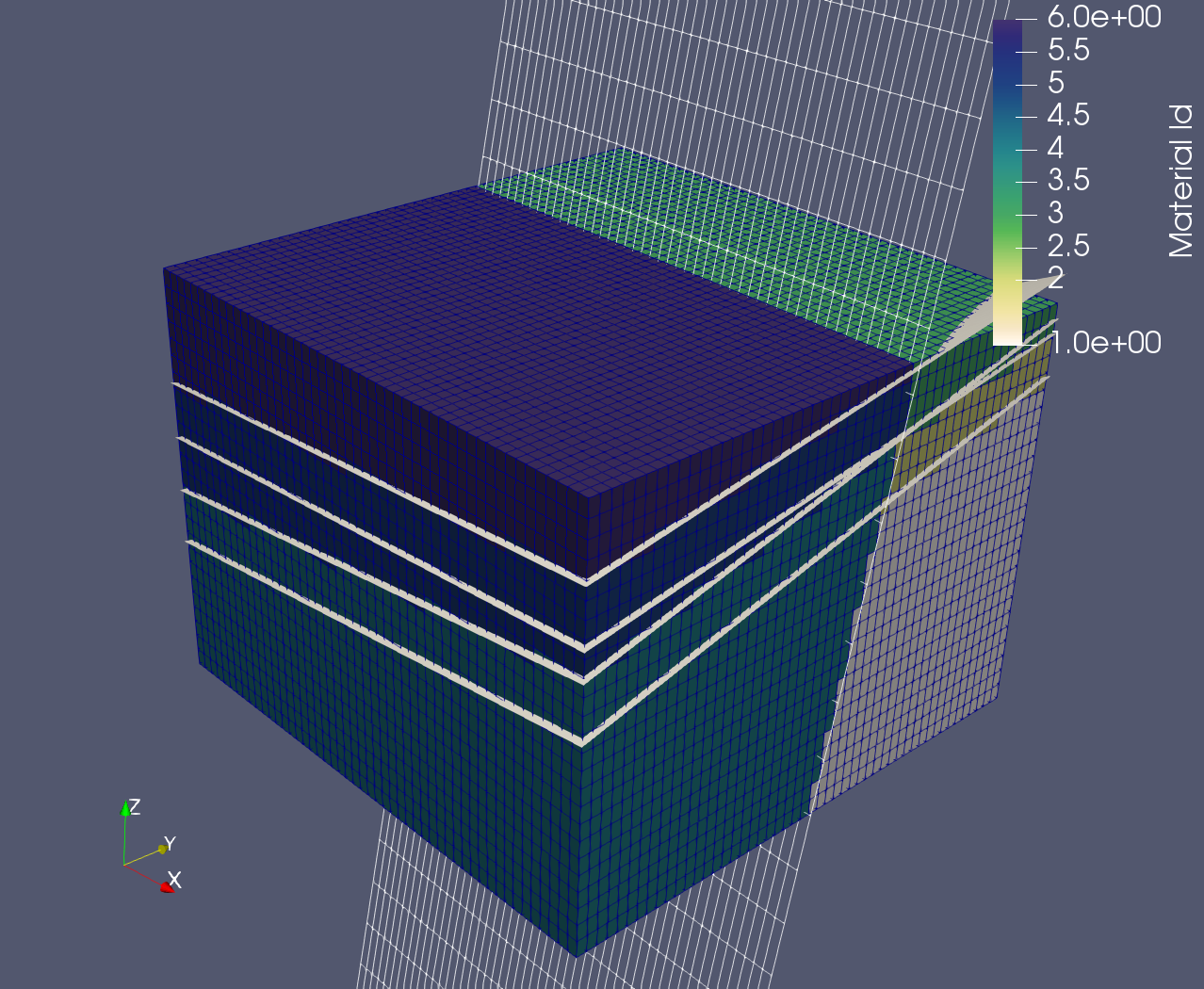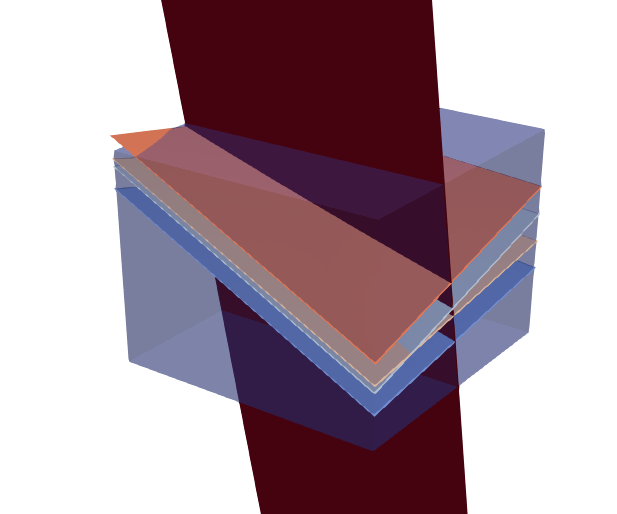5. Constructing a Fault and Layers
5.1 Creating a Fault and Subsurface Layers
Next, we are going to map a fault and surfaces to our mesh. The objects created will be:
For all five of these surfaces, we will:
- Define the X,Y,Z extent
- Use
quadxyto generate the point distribution - Connect the points into a quad mesh using
createpts/brick.
For the main fault mesh, this process looks like:
cmo / create / mosurf_fault
cmo / select / mosurf_fault
define / X0S / -20.0
define / X1S / 4020.0
define / Y0S / -20.0
define / Y1S / 4020.0
define / Z1 / -1.e4
define / Z2 / -1.e4
define / Z3 / 1.e4
define / Z4 / 1.e4
quadxy / NX NY /X0S Y0S Z1/X1S Y0S Z2/X1S Y1S Z3/X0S Y1S Z4
createpts/brick/xyz/ NX NY 1 /1,0,0/connect
cmo / printatt / mosurf / -xyz- / minmax
For the remaining four surfaces this process is repeated, with Z1,Z2,Z3,Z4
altered independently.
The created surfaces have the names mosurf1_fminus, mosurf2_fminus,
mosurf1_fplus, mosurf2_fplus, and mosurf_fault.
5.2 Define Geometry of Hydrostratigraphic Model
Recall in step 4 how we used two surface meshes to alter imt and itetclr
values: first, by defining surfaces from the planar meshes; second, using the
surface objects to define region objects; third, creating psets and
eltsets from the regions; and finally, by modifying itetclr and imt
through the defined psets and eltsets.
This process is replicated here. First, by creating the surfaces:
surface / s_1_fm / reflect / sheet / mosurf1_fminus
surface / s_2_fm / reflect / sheet / mosurf2_fminus
surface / s_1_fp / reflect / sheet / mosurf1_fplus
surface / s_2_fp / reflect / sheet / mosurf2_fplus
surface / s_f / reflect / sheet / mosurf_fault
Then, by mapping the surfaces to regions (and deleting the planar meshes to free up memory):
region / r_1_fm / le s_1_fm and le s_f
region / r_2_fm / gt s_1_fm and le s_2_fm and le s_f
region / r_3_fm / gt s_2_fm and le s_f
region / r_1_fp / le s_1_fp and gt s_f
region / r_2_fp / gt s_1_fp and le s_2_fp and gt s_f
region / r_3_fp / gt s_2_fp and gt s_f
cmo / delete / mosurf1_fminus
cmo / delete / mosurf2_fminus
cmo / delete / mosurf1_fplus
cmo / delete / mosurf2_fplus
cmo / delete / mosurf_fault
And finally, by creating psets and eltsets and using them to modify material
attributes of the parent mesh:
pset / p_r_1_fm / region / r_1_fm / 1 0 0
pset / p_r_2_fm / region / r_2_fm / 1 0 0
pset / p_r_3_fm / region / r_3_fm / 1 0 0
pset / p_r_1_fp / region / r_1_fp / 1 0 0
pset / p_r_2_fp / region / r_2_fp / 1 0 0
pset / p_r_3_fp / region / r_3_fp / 1 0 0
eltset / e_r_1_fm / region / r_1_fm
eltset / e_r_2_fm / region / r_2_fm
eltset / e_r_3_fm / region / r_3_fm
eltset / e_r_1_fp / region / r_1_fp
eltset / e_r_2_fp / region / r_2_fp
eltset / e_r_3_fp / region / r_3_fp
cmo / setatt / MONAME / imt / 1 0 0 / 7
cmo / setatt / MONAME / itetclr / 1 0 0 / 7
cmo / setatt / MONAME / imt / pset get p_r_1_fm / 1
cmo / setatt / MONAME / imt / pset get p_r_2_fm / 2
cmo / setatt / MONAME / imt / pset get p_r_3_fm / 3
cmo / setatt / MONAME / imt / pset get p_r_1_fp / 4
cmo / setatt / MONAME / imt / pset get p_r_2_fp / 5
cmo / setatt / MONAME / imt / pset get p_r_3_fp / 6
cmo / setatt / MONAME / itetclr / eltset get e_r_1_fm / 1
cmo / setatt / MONAME / itetclr / eltset get e_r_2_fm / 2
cmo / setatt / MONAME / itetclr / eltset get e_r_3_fm / 3
cmo / setatt / MONAME / itetclr / eltset get e_r_1_fp / 4
cmo / setatt / MONAME / itetclr / eltset get e_r_2_fp / 5
cmo / setatt / MONAME / itetclr / eltset get e_r_3_fp / 6
The six distinct regions can now be seen by viewing itetclr on the
parent mesh:

